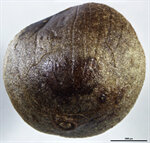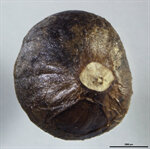Taxonomy
Chrysanthemoides monilifera (L.) Norl., Stud. Calenduleae i. 374. 1943.Common synonyms
Osteospermum moniliferum L., Sp. Pl. 2: 923. 1753.Common name
Bitou bush, salt bush, boneseed
Description
Propagule or dispersal unit is the fruit. Fertile part 5-8 mm long, 5-8 mm wide, in side view +/- globular, +/- straight, the upper (apical) end narrowing, in cross-section round, basal scar (carpopodium) inconspicuous and undifferentiated, central, beak (=thinner sterile stalk between seed and pappus) absent, wings absent, fruit surface black, rarely dark brown (by misinterpretation), smooth (except at cellular level), rarely wrinkled (by misinterpretation), with no hairs (glabrous), thickened margin absent, longitudinal ribs absent.
Pappus absent.
Notes: This species is extremely unusual in the daisy family in having fleshy, bird-dispersed fruits.
Ecology
Shrub, fruit bird-dispersed. Tolerant of salt, strong wind, drought, low nutrients and low frequency/intensity fire. Coastal dunes and coastal bushland.
Native range
Mozambique, South Africa. (Also Namibia, Zimbabwe, Tansania, Kenya?)
Introduced range
United States (California), France, Italy, Australia, New Zealand, but apparently problematic only in Australia.
Weed status within Australia
Weed of National Significance (WONS); Qld Restricted Invasive Plant Cat. 2-5; NSW Class 1 State Prohibited Weed; Vic Regionally Prohibited of Controlled; SA Category 2 Declared Weed; WA Declared Pest – s12 (C1 Prohibited); Tas Declared.
Past interceptions (Australia): commodities
New vehicles, containers.

